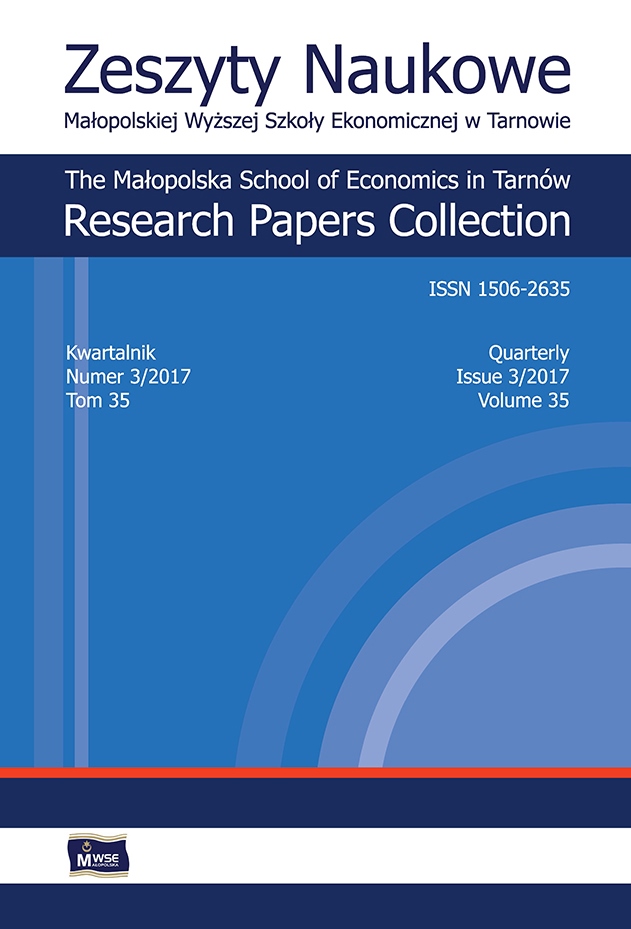Abstract
This following article presents the factors that have caused DCT container terminal’s dynamic development since 2007 whereas in the same period the terminals in Gdynia did not significantly broaden their scale, despite an increase of the entire container handling market. The research methods used are the secondary data analysis and expert interviews conducted with the industry representatives. In the first part the authors presented the trends in the development of the global container handling market. Next, the authors showed the structure of the Polish container handling market and comparison of handlings of leading container terminals in Poland in 2007–2016. In the analysed period, significant differences in the dynamics of the handlings volume growth were observed, thus the characteristics of particular terminals were compared in order to find out the reasons of this situation. In the following part, the leading Polish container terminals were characterised: GCT SA and BCT SA in Gdynia, and DCT SA in Gdansk. In the last part of the article, the authors analysed the factors that determined the increase in the number of handlings made by DCT Gdansk. Furthermore, the reasons that prevented the development of terminals located in Gdynia were presented.
References
Alphaliner. (2014). Weekly Newsletter, 32. London: Alphaliner.
View in Google Scholar
BCT. (2011). Podstawowe informacje [online, dostęp: 2017-06-15]. Gdynia: Baltic Container Terminal. Dostępny w Internecie: http://www.bct.gdynia.pl/o-bct/podstawowe-informacje.
View in Google Scholar
Broeze, F. (2002). The Globalisation of the Oceans Containerization from the 1950s to the Present. St. John’s: International Maritime Economic History Association. ISBN 0973007338.
View in Google Scholar
Cabrera, N. (2014). The Largest Container Ships in the World: CSCL Globe, MSC Oscar [online, dostęp: 2017-06-15]. Shipping & Logistics Blog. Doral, FL: Lilly + Associates International. Dostępny w Internecie: http://www.shiplilly.com/blog/largest-ships-world-cscl-globe-msc-oscar/.
View in Google Scholar
Davidson, N. (2016). The Global Container Market Outlook: Ports and Terminals. Amsterdam.
View in Google Scholar
DCT Gdańsk. (2014). Historia [online, dostęp: 2017-06-15]. Gdańsk: Deepwater Container Terminal Gdańsk. Dostępny w Internecie: http://dctgdansk.pl/pl/about-dct/history/.
View in Google Scholar
DCT Gdańsk. (2017). Przetargi [online, dostęp: 2017-06-15]. Gdańsk: Deepwater Container Terminal Gdańsk. Dostępny w Internecie: http://dctgdansk.pl/pl/p-17-1-po1-zaprojektowanie-rozbudowy-terminalufaza-t2b/.
View in Google Scholar
Dolecki, L. (2016). Czy DCT „pożre” inne terminale kontenerowe? [online, dostęp: 2017-06-15]. Rynek Infrastruktury. Warszawa: Zespół Doradców Gospodarczych „TOR”. Dostępny w Internecie: http://www.rynekinfrastruktury.pl/wiadomosci/czy-dct-pozre-inne-terminale-kontenerowe-52418.html.
View in Google Scholar
Eurostat. (2013). Glossary: Twenty-foot equivalent unit (TEU) [online, dostęp: 2017-03-20]. Eurostat Statistics Explained. Luxembourg: Eurostat. Dostępny w Internecie: http://ec.europa.eu/eurostat/statistics-explained/index.php/Glossary:Twenty-foot_equivalent_unit_(TEU).
View in Google Scholar
GCT. (2010). Terminal [online, dostęp: 2017-06-15]. Gdynia: Gdynia Container Terminal. Dostępny w Internecie: http://www.gct.pl/terminal.
View in Google Scholar
Gospodarka Morska. (2010). DCT Gdańsk jeszcze bliżej Azji [online, dostęp: 2017-06-15]. Portal Gospodarka Morska.pl. Dostępny w Internecie: http://www.gospodarkamorska.pl/Porty,Transport/dct-gdansk-jeszcze-blizej-azji.
View in Google Scholar
Gospodarka Morska. (2011). Największe kontenerowce świata zawiną do DCT Gdańsk [online, dostęp: 2017-06-15]. Portal Gospodarka Morska.pl. Dostępny w Internecie: http://www.gospodarkamorska.pl/wydarzenia/najwieksze-kontenerowce-swiata-zawina-do-dct-gdansk.html.
View in Google Scholar
Grzybowski, M. (2014). Alianse strategiczne w transporcie morskim. Kontekst Regionu Morza Bałtyckiego. Logistyka, 2, 74–79.
View in Google Scholar
Hand, M. (2017). OOCL Hong Kong takes the world’s largest containership crown [online, dostęp: 2017-06-15]. Seatrade Maritime News. Dostępny w Internecie: http://www.seatrade-maritime.com/news/asia/oocl-hong-kong-takes-the-world-s-largest-containership-crown.html.
View in Google Scholar
Jones Lang LaSalle. (2013). Polskie porty kontenerowe: nowe kierunki rozwoju rynku logistycznego. Warszawa: Jones Lang LaSalle.
View in Google Scholar
Koźlak, A. (2010). Rola transportu morskiego w globalnej gospodarce. W: H. Klimek, J. Dąbrowski (red.). Kierunki rozwoju polskiego transportu morskiego – programy i rzeczywistość. Gdańsk: Fundacja Rozwoju Uniwersytetu Gdańskiego. ISBN 9788375310740.
View in Google Scholar
Majszyk, K. (2015). Polskie porty rosną. Przeładowano rekordowe 2 mln kontenerów [online, dostęp: 2017-06-15]. Forsal.pl. Dostępny w Internecie: http://forsal.pl/artykuly/849235,polskie-porty-rosnaprzeladowano-rekordowe-2-mln-kontenerow.html.
View in Google Scholar
Portal Morski. (2016). Otwarcie T2 – nowej części terminalu DCT Gdańsk [online, dostęp: 2017-06-15]. PortalMorski.pl: branżowy serwis informacyjny. Dostępny w Internecie: http://www.portalmorski.pl/portylogistyka/33358-otwarcie-t2-nowej-czesci-terminalu-dct-gdansk.
View in Google Scholar
Przybylski, R. (2010). Hamburg, największy polski port [online, dostęp: 2017-06-05]. Rzeczpospolita, 25.03. Dostępny w Internecie: http://www.rp.pl/artykul/451689-Hamburg--najwiekszy-polski-port.html.
View in Google Scholar
Rydzkowski, W., Gus-Puszczewicz, A. (2010). Wpływ kryzysu gospodarczego na obroty kontenerowe w Gdańsku i Gdyni. Przegląd Komunikacyjny, 7–8, 10–14.
View in Google Scholar
Rynek Infrastruktury. (2004). GCT Gdynia: trwa III etap rozbudowy [online, dostęp: 2017-06-15]. Rynek Infrastruktury. Warszawa: Zespół Doradców Gospodarczych „TOR”. Dostępny w Internecie: http://www.rynekinfrastruktury.pl/wiadomosci/gct-gdynia-trwa-iii-etap-budowy-7296.html.
View in Google Scholar
Spigarski, C. (2015). BCT otrzymał nowe suwnice [online, dostęp: 2017-06-15]. Gdańsk: Fundacja Promocji Przemysłu Okrętowego i Gospodarki Morskiej. Dostępny w Internecie: http://oficynamorska.pl/2015/bct-otrzymal-nowe-suwnice/.
View in Google Scholar
UNCTAD. (2016). Review of Maritime Transport 2016: report by the secretariat of UNCTAD. New York: United Nations. ISSN 0566-7682.
View in Google Scholar
Zarząd Morskiego Portu Gdańsk. (2017). Terminal kontenerowy DCT Gdańsk [online, dostęp: 2017-06-15]. Port Gdańsk. Dostępny w Internecie: https://www.portgdansk.pl/o-porcie/terminal-kontenerowy-dct-gdansk.
View in Google Scholar
Zarząd Morskiego Portu Gdynia. (2016). Pogłębienie toru podejściowego i akwenów wewnętrznych Portu Gdynia – Etap I [online, dostęp: 2017-06-15]. Port Gdynia. Dostępny w Internecie: http://www.port.gdynia.pl/pl/wydarzenia/kontenerowce/602-poglebienie-toru-podejsciowego-i-akwenow-wewnetrznychportu-gdynia-etap-i.
View in Google Scholar
© Copyright by Małopolska School of Economics in Tarnów. The articles are available under the Creative Commons Attribution NonCommercial-NoDerivatives 4.0 International License


